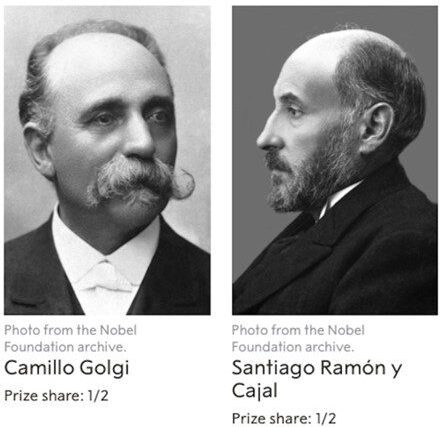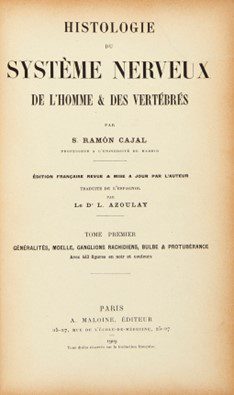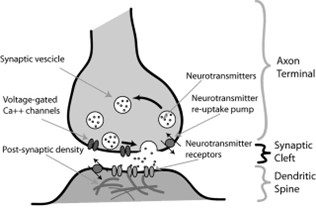JMS Pearce
Hull, England

Fig 1. Camillo Golgi and Santiago Ramon y Cajal. From “The Nobel Prize in Physiology or Medicine 1906,” The Nobel Prize.
There can be few medical works of such importance as the study of the fine structure of the nerve cell that began in the last three decades of the nineteenth century. The two principal adventurers (Fig 1) in this field were the Italian Camillo Golgi (1843–1926) and the Spaniard Santiago Ramón y Cajal (1853–1934).
Born in Corteno, Camillo Golgi graduated in medicine at the University of Pavia in 1865. Cesare Lombroso encouraged his studies of the brain, and in Giulio Bizzozero’s laboratory, he studied histology. In 1872 he moved to Abbiategrasso in Milan as chief of a hospital for chronic diseases. When Golgi began his work there, existing staining techniques were crude and failed to show fine details of the nerve cells. He experimented by candlelight in the hospital kitchen. By impregnating neural tissue with potassium dichromate and silver nitrate, he was able in 1873 to stain the myelin sheath of branching axons1 and clearly view single dissected neurons, in which he identified an internal compartmentalized organelle, the Golgi apparatus.2
His staining technique was called the “Black Reaction” (La reazione nera), which was to become the foundation for the histology of the nervous system.3 It enabled him to propose a diffuse nervous net theory in which axons and dendrites were linked to form the nervous system. However, Joseph von Gerlach (1820–1896), a keen microphotographer and anatomist from Erlanger University, had earlier proposed a similar notion: “cells are interconnected . . . whereby a coarsely meshed network of modulated fibers is produced which can already be seen at 60 times magnification.”4 Although a discovery of great importance, Golgi’s silver staining method was largely ignored until the advent of Santiago Ramón y Cajal.5

Fig 2. Cajal’s Histologie système nerveux.
Cajal was born in Petilla de Aragón and was a rebellious schoolboy. He studied at the University of Zaragoza medical school, where his father worked as an anatomist. He became MD at Madrid in 1877 and Professor of Histology and Pathological Anatomy at the Universities of Valencia, then Barcelona. In 1888 Cajal improved Golgi’s technique and cellular resolution (Fig 2).6 He described how, by improving the Golgi stain, he discovered varied forms of terminal and collateral ramifications of the axis cylinder, their contacts with the nerve cells and dendrites, the role of the soma (cell body) and offshoots of nerve cells as conducting chains, and the conduction of nervous impulses by contact or induction. This he described in Textura del Sistema Nervioso del Hombre y los Vertebrados (1899–1904).7* Thus, instead of Golgi’s network, Cajal showed in his superb pen and ink drawings8 that axons end independently in the gray matter of the nervous system, but never as a network with other axon terminals. Single neurons could communicate with each other via their dendrites and axons, which carried signals of electrical voltage (DuBois-Reymond’s action potentials). Cajal therefore proposed the Neuron Doctrine or Neuron Theory whereby the individual neuron was the basic structural and functional unit of the nervous system, which founded the organization of the nervous system.7 (Fig 2)
At the Royal Society, Cajal gave the 1894 Croonian lecture titled La fine structure des centres nerveux.9 He subsequently showed regenerative sprouting from the proximal stump of severed nerves; this was another manifestation of his Neuron Doctrine, whereby the cell bodies (neurons) conveyed information not by direct contact but by electrical and chemical transmission through nerve fibers that traversed the space between them, later known as the synaptic cleft.10 (Fig 3)
The eminent Swiss histologist Rudolf Albert von Koelliker (1817–1905) changed his support for Golgi’s network to Cajal’s neuron doctrine, the term used by Wilhelm Waldeyer (1836–1921) in 1891, who also invented the name “neuron.”
Golgi’s “reticularist” views of a diffuse net opposed Cajal’s demonstration of multiple single neurons with dendritic branches, cell body, and axonal terminations. According to Golgi’s theory, the nervous system functioned as a single unit, with the fibers acting in a coordinated network to transmit signals. Golgi and Cajal shared the Nobel Prize in 1906 “in recognition of their work on the structure of the nervous system.” But they staunchly held very different views. Cajal was an artist, inclined to solitude but ambitious, strong-willed, and tenacious. Golgi, despite facing numerous setbacks and obstacles throughout his career, remained a dedicated investigator; he was known for his working closely with many colleagues. Contradicting this view of Golgi, it was said that the Nobel ceremony was spoiled for Cajal by the alleged “pompous and tedious self-reference of his fellow-prizeman, who . . . took all the credit to himself for the neuron theory and the finer anatomy of the nerve centres.”5,11 When they were awarded the Nobel Prize, Golgi persisted in refuting the “neuron theory” for which Cajal was largely responsible and adhered to his concept of a continuous neural network. Garrison commented:

Fig 3. The synapse or synaptic cleft. From “Synaptic Cleft,” The Human Memory.
At Stockholm, in contrast with Golgi, Cajal enlarged, with generous profusion, upon the work of the men who had initiated, confirmed and supplemented his own endeavors. The life-long intransigence of Golgi puzzled him. Despite their difference, Golgi and Cajal became the first scientists to share a Medicine Prize.10
Golgi returned to Pavia as Professor of Histology and General Pathology, there to make many other major discoveries including the anatomy of the nephron, the Golgi tendon organ, and the Golgi cycle of malarial parasites, which still bear his name. He died in Pavia on 21 January 1921.3
Regardless of their differences, the investigations of Cajal and Golgi were intertwined and illuminated the dark recesses of fine neural structures and connections. Our knowledge of the nervous system at the cellular level, both in health and disease, derives from the concept that organization is through the connectivity of functionally independent neurons and their processes.
Golgi and Cajal strongly influenced the subsequent work of Sir Charles Scott Sherrington (1857–1952) who in 1897 postulated the synapse12 (Fig 3), which fifty years later was demonstrated by electron microscopy. The inexhaustible Douglas Edgar Adrian (1889–1977) developed techniques for recording the electrical discharges in single nerve fibers.13,14 And in 1932, Adrian with Sherrington, the humble, philosophical scientist, shared a Nobel Prize “for their discoveries regarding the functions of neurons.” Demonstration of intracellular recordings eventually laid the foundation for studies of the neuronal membrane and neurotransmission by the 1963 Nobel laureates Sir Andrew Huxley (1917–2012), Sir Alan Hodgkin (1914–1998), and Sir John Eccles (1903–1997).
Note
* According to an AbeBooks listing by Sophia Rare Books, the only known presentation copy was exhibited at the Grolier Club in 1995. The listing values the book at £48,533.13.
References
- Ghosh SK. Camillo Golgi (1843-1926): scientist extraordinaire and pioneer figure of modern neurology. Anat Cell Biol 2020;53(4):385-392.
- Golgi C. (1885) Sulla fina anatomia degli organi centrali del sistema nervoso Revista sperimentale di Freniatria. Reprint in: Golgi C., Opera omnia. Milan: Hoepli, 1903.
- Mazzarello P. Camillo Golgi’s scientific biography. J Hist Neurosci 1999;8:121-31.
- Von Gerlach J. On the Structure of the Grey Matter in the Human Cerebrum. Preliminary Communication. Centralblatt fuer die medizinischen Wissenschaften 1872.
- Garrison FH. Ramon Y Cajal. Bulletin of the New York Academy of Medicine 1929; 5(6):483-508.
- Ramón Y Cajal S. Histologie du système nerveux de l’homme & des vertébrés … Édition français revue & mise à jour par l’auteur. Trans: L. Azoulay. Paris: E. Arrault et Cie for A. Maloine, 1909-1911.
- Ramón Y Cajal S. Textura del Sistema Nervioso del Hombre y los Vertebrados. Madrid: Nicolas Moya, 1899-1904.
- Maina S. The intricate forest of the neuron. Hektoen International Summer 2021.
- De Carlos JA and Molnár Z. Cajal’s Interactions with Sherrington and the Croonian Lecture. Anat Rec 2020; 303(5): 1181-1188. https://doi.org/10.1002/ar.24189.
- Jones EG. Golgi, Cajal and the Neuron Doctrine. Journal of the History of the Neurosciences 1999;8(2): 170-178.
- Grant G. How Golgi Shared the 1906 Nobel Prize in Physiology or Medicine with Cajal. The Nobel Prize 1999. https://nobelprize.org/prizes/medicine/1906/article/.
- Sherrington CS. The integrative action of the nervous system. New York: C. Scribner’s Sons, 1906.
- Adrian ED. The physical background of perception. Oxford: Clarendon Press, 1947.
- Pearce JMS. Lord Adrian, MD, PRS, OM. Eur Neurol 2018;79:64-67.
JMS PEARCE is a retired neurologist and author with a particular interest in the history of medicine and science.

Leave a Reply